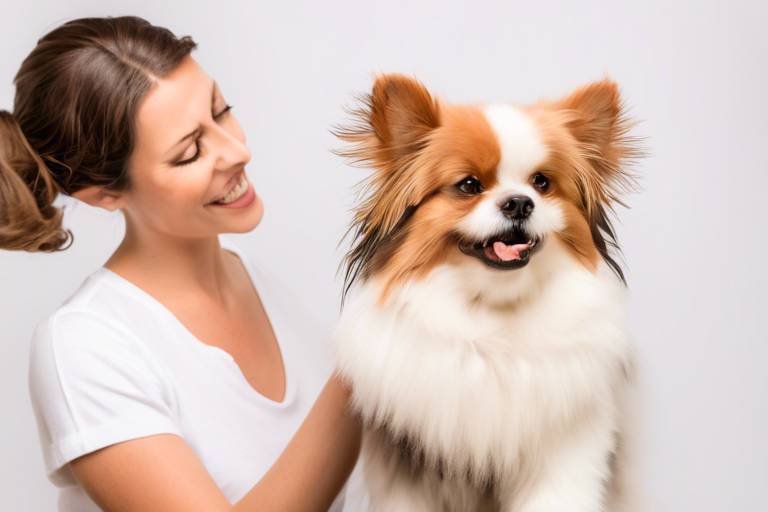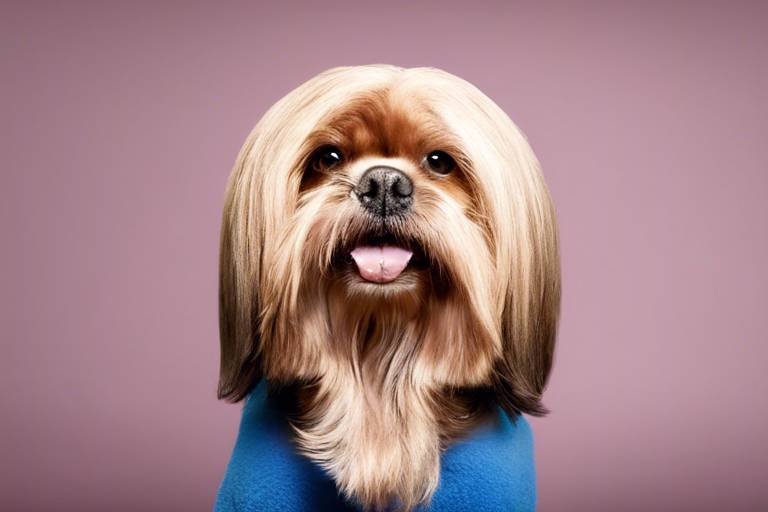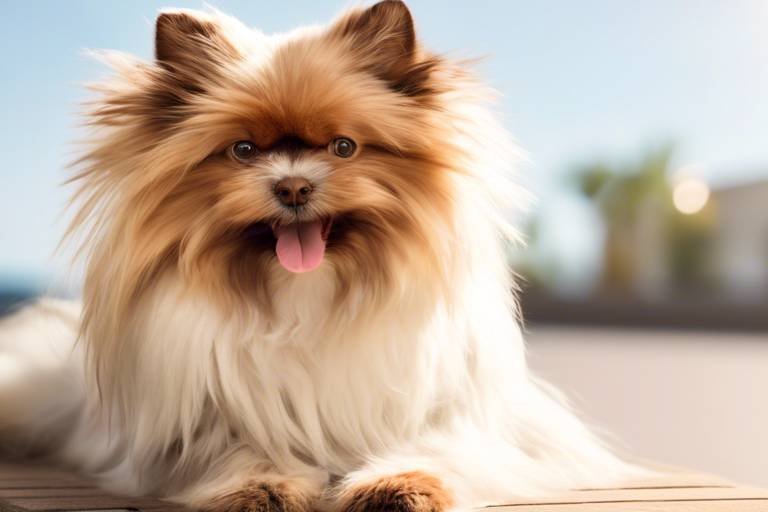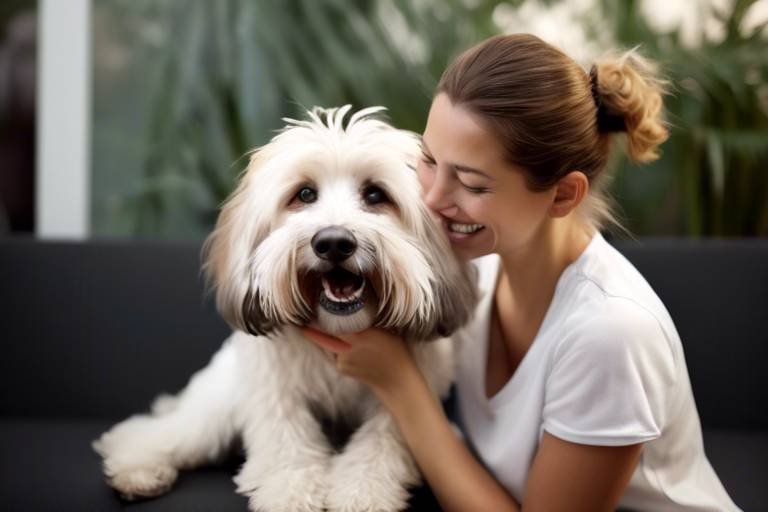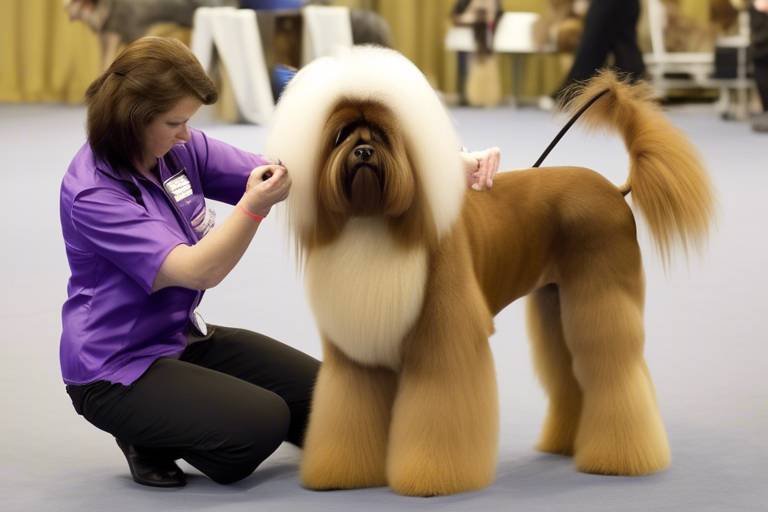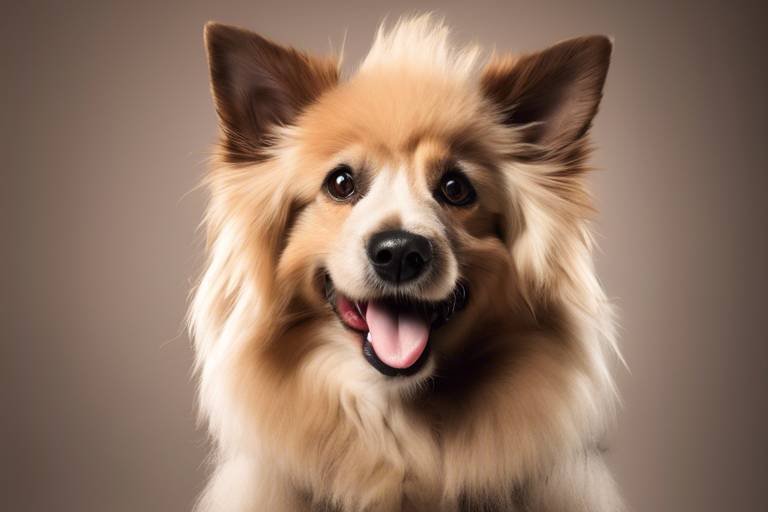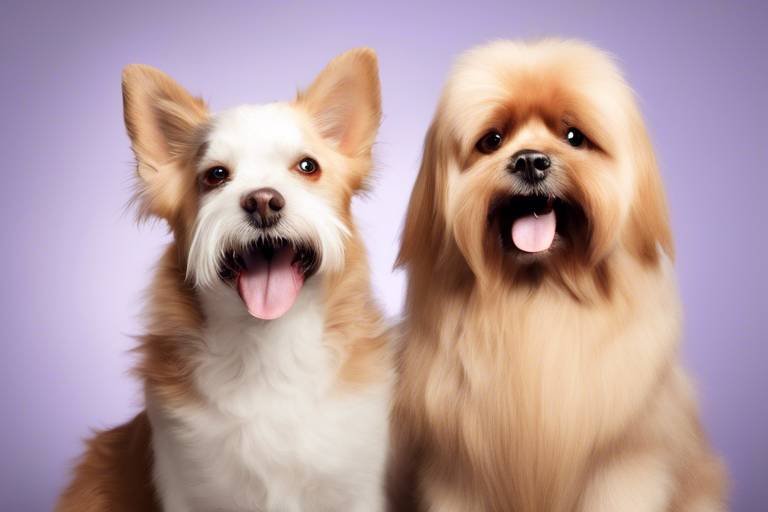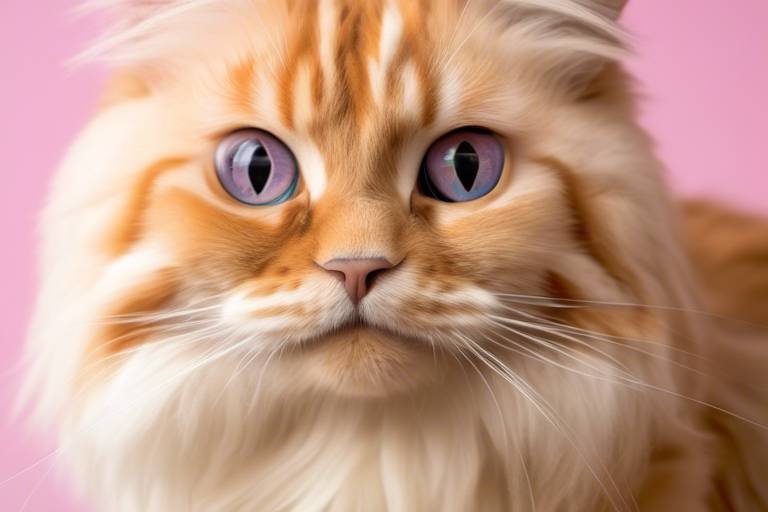How to Help Your Pet Adjust to Grooming Routines
Grooming your pet can sometimes feel like a daunting task, but it doesn't have to be! Just like us, our furry friends can have their quirks and preferences. Helping your pet adjust to grooming routines is not only about making them look good; it’s also about keeping them healthy and happy. Imagine trying to get a toddler to sit still for a haircut—it's all about patience, understanding, and a bit of fun! In this article, we’ll dive deep into practical tips and techniques that will ease your pet into grooming, ensuring a positive experience for both of you. So, let's roll up our sleeves and get started!
Before we jump into the nitty-gritty of grooming tools and techniques, it's essential to understand your pet's behavior. Just like humans, pets communicate their feelings through body language. For instance, if your dog is wagging its tail, it’s usually a good sign, but if those ears are pinned back and the tail is low, your furry friend might be feeling anxious. Recognizing these signals can help you create a comfortable grooming environment. Pay attention to their posture, vocalizations, and even their breathing patterns. A relaxed pet is much easier to groom!
Selecting the appropriate grooming tools can significantly impact your pet's comfort during grooming. The right tools can make the process smoother and more enjoyable. Imagine trying to comb through tangled hair with a fork—frustrating, right? Instead, let’s explore the tools that will help make grooming a breeze for both you and your pet.
Different fur types require specific brushes and combs. For example, short-haired pets may only need a simple bristle brush, while long-haired breeds thrive with a slicker brush or a wide-toothed comb. Choosing the right brush not only helps remove loose hair but also stimulates the skin and distributes natural oils for a shiny coat. Here’s a quick guide:
| Fur Type | Recommended Tool |
|---|---|
| Short Hair | Bristle Brush |
| Medium Hair | Slicker Brush |
| Long Hair | Wide-Toothed Comb |
Shedding can be a pet owner's nightmare, but deshedding tools can help manage excessive fur loss. Tools like the Furminator can effectively reduce shedding while keeping your pet comfortable. Just remember to use these tools gently—think of it as giving your pet a relaxing massage rather than a chore!
When it comes to trimming your pet's fur, understanding how to use clippers and scissors safely is crucial. Always opt for pet-specific clippers that are quieter and designed to minimize anxiety. Start with small areas to help your pet get used to the sound and sensation. Practice makes perfect, so take your time and don’t rush the process!
Bathing is another integral part of grooming. It’s not just about getting rid of dirt; it’s about caring for your pet's skin and coat. Selecting the right shampoos and conditioners based on your pet’s skin type is vital. For instance, if your pet has sensitive skin, look for hypoallergenic products. A good rule of thumb is to read labels and choose products that are free from harsh chemicals.
A calm and positive environment is vital for successful grooming. Think of it as setting the stage for a pleasant experience. Start by choosing a quiet space with minimal distractions. You might even want to play some soft music to help soothe your pet’s nerves. Creating a cozy atmosphere can work wonders in making your furry friend feel safe and relaxed.
Incorporating treats and rewards during grooming can significantly help build positive associations. Imagine being rewarded with a delicious snack every time you did something challenging—wouldn’t that make it easier? Use small treats to encourage good behavior and let your pet know they’re doing great. This can make a world of difference in their attitude toward grooming!
Gradually introducing grooming tools can reduce anxiety. Start by letting your pet sniff and explore the tools before using them. This is akin to introducing a new toy to a child; it’s all about making it familiar and fun! Over time, your pet will become more comfortable with the grooming process.
Consistency is key to helping your pet adjust to grooming. Establishing a regular grooming schedule that works for you and your pet is essential. Think of it as a bonding time—both of you can look forward to it! Whether it’s once a week or every other week, find a rhythm that suits your lifestyle.
Understanding how often grooming should occur based on your pet's breed and coat type is essential. For instance, long-haired breeds may require grooming every few days, while short-haired pets might only need it once a month. Regular grooming not only keeps your pet looking their best but also helps you monitor their health.
Regularly assessing your pet's comfort levels during grooming can help you make necessary adjustments. Watch for signs of stress, such as panting, whining, or trying to escape. If you notice any discomfort, take a break and try again later. Remember, it’s all about making grooming a positive experience!
- How often should I groom my pet? It depends on the breed and coat type. Long-haired pets may need grooming every few days, while short-haired ones might need it once a month.
- What should I do if my pet is afraid of grooming? Gradually introduce grooming tools and use treats to create positive associations.
- Are there specific grooming products I should use? Yes, choose products based on your pet’s skin and coat type, and always opt for pet-specific grooming tools.
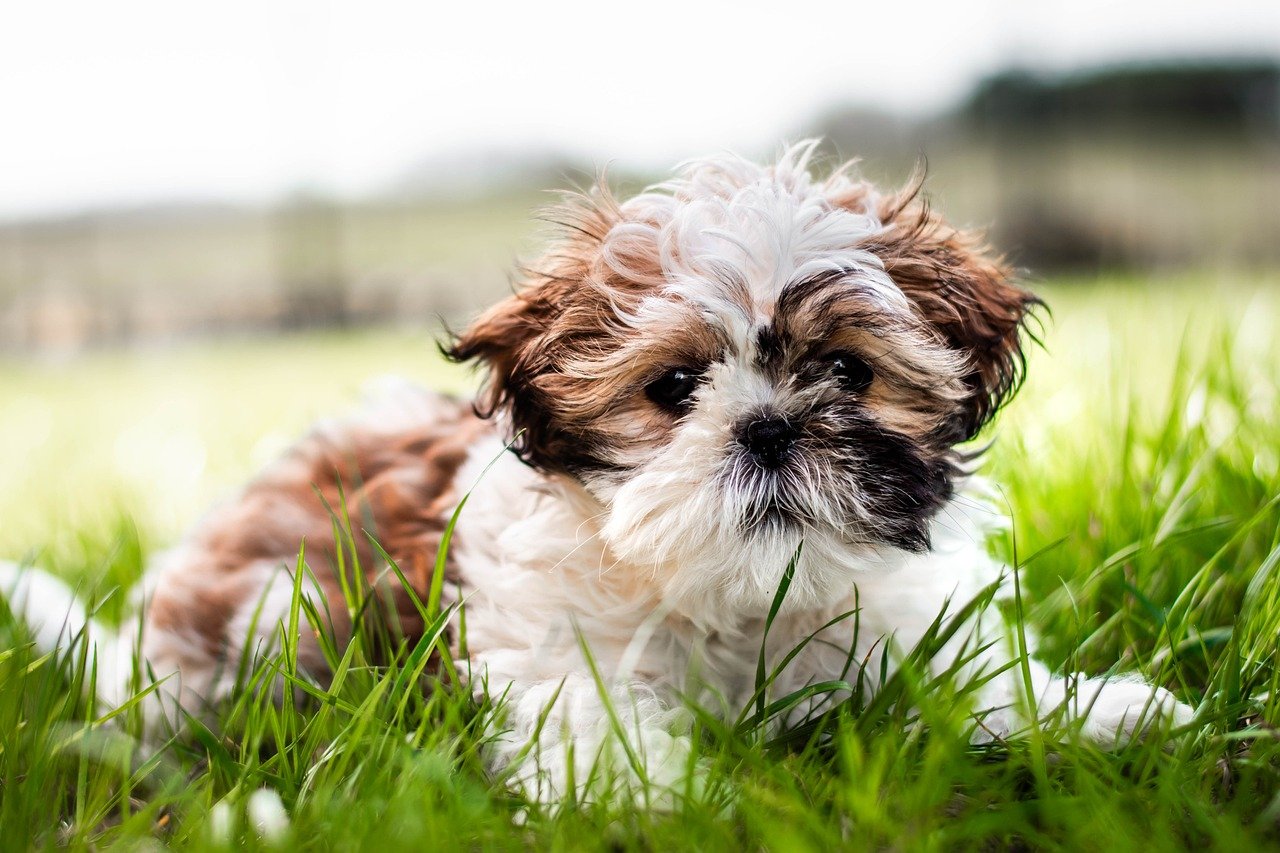
Understanding Your Pet's Behavior
When it comes to grooming your furry friend, understanding their behavior is absolutely crucial. Just like humans, pets have their own unique ways of expressing feelings, and being able to read these signals can make all the difference during grooming sessions. Imagine trying to have a conversation with someone who isn’t listening; it’s frustrating, right? Well, the same goes for your pet. If you miss their cues, you might end up causing them unnecessary stress. So, let’s dive into how you can become a pet behavior detective!
First off, let’s talk about body language. Your pet's posture, tail position, and even their ears can tell you a lot about how they’re feeling. For instance, a relaxed dog will typically have a loose body, a wagging tail, and ears that are either neutral or slightly back. On the other hand, if your pet seems tense, with a stiff body and a tucked tail, it’s a clear sign they might not be too keen on the idea of grooming. Being observant is key!
Another important aspect to consider is vocalization. Dogs may bark, whine, or growl when they are feeling anxious or uncomfortable. Cats, on the other hand, might hiss or swat when they’re not in the mood. It’s essential to recognize that these sounds are their way of communicating discomfort. If your pet is vocalizing, it’s a good idea to pause and assess the situation. Are they feeling overwhelmed? Do they need a break? Listening to their sounds can guide you in making the grooming experience more enjoyable.
Additionally, you may notice certain behaviors that indicate stress or anxiety. For example, if your furry friend tries to escape or hides when they see the grooming tools, it’s a clear indication that they associate grooming with something negative. In such cases, it’s important to take a step back and re-evaluate your approach. Consider introducing the grooming tools gradually, allowing your pet to sniff and explore them without immediately jumping into the grooming process. This way, you can help them build a positive association with grooming.
To further help you understand your pet’s behavior, here’s a quick summary of common signs to watch for:
- Relaxed Body Language: Loose posture, wagging tail, and ears in a neutral position.
- Tension: Stiff body, tucked tail, and ears pinned back.
- Vocalization: Whining, barking, or growling can indicate discomfort.
- Avoidance: Hiding or trying to escape shows anxiety about grooming.
Understanding these behaviors is just the first step. You also need to adapt your grooming techniques to your pet's needs. For instance, if your pet is particularly sensitive to touch, you might want to use softer brushes and take your time. Always remember that the goal is to create a calm and enjoyable environment for your pet. The more comfortable they feel, the more they’ll look forward to grooming sessions in the future!
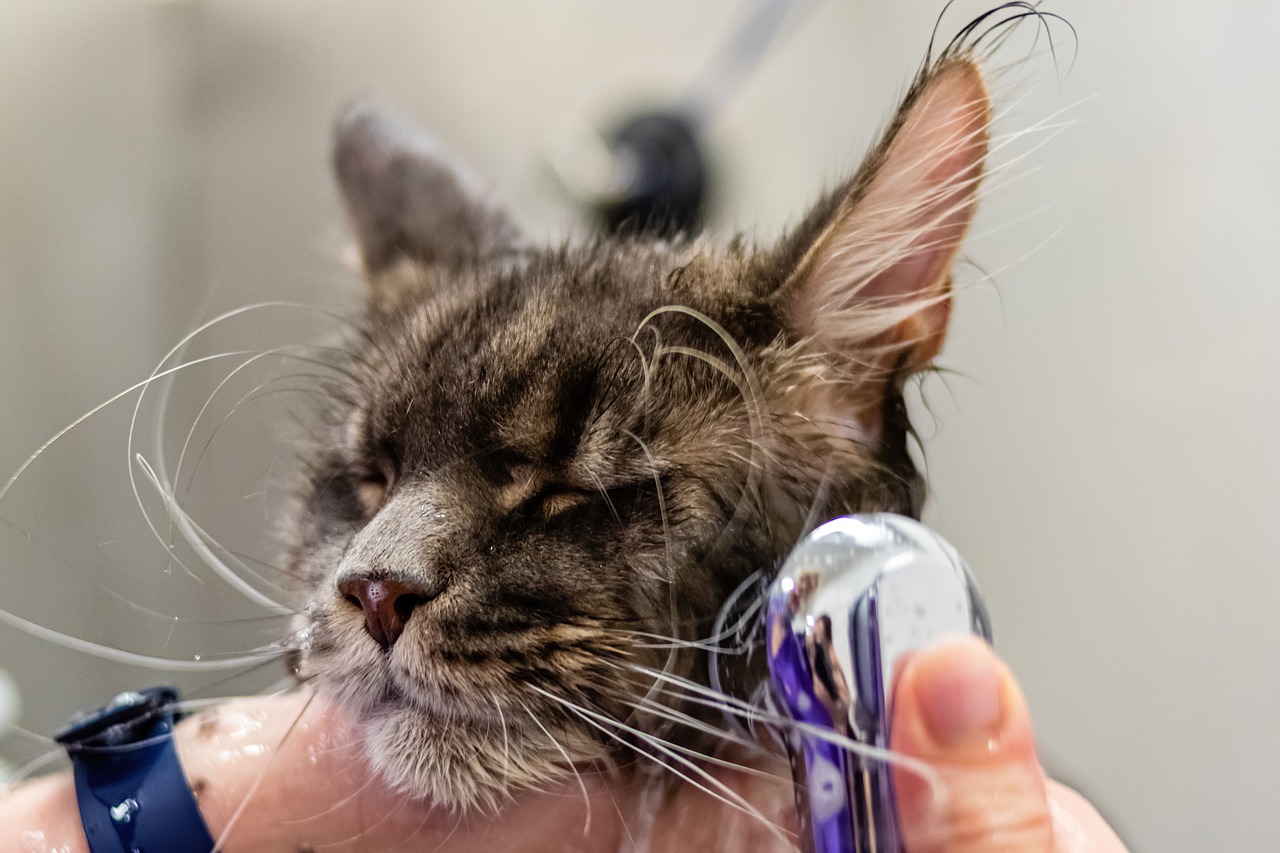
Choosing the Right Grooming Tools
When it comes to grooming your beloved pet, choosing the right tools can make all the difference between a stressful experience and a pleasant one. Just like you wouldn’t use a butter knife to cut a steak, you shouldn’t use just any grooming tool on your furry companion. The right tools cater to your pet's specific needs, ensuring their comfort and your efficiency. So, let’s dive into the world of grooming tools and discover what works best for your pet!
First off, it’s essential to consider your pet’s coat type. Is your pet a fluffy golden retriever or a sleek Siamese cat? Different fur types require different grooming tools. For instance, long-haired breeds often benefit from wide-toothed combs and slicker brushes, while short-haired pets might only need a rubber grooming mitt to remove loose hairs. Understanding these distinctions can save you both time and hassle during grooming sessions.
Brushes and combs are your primary weapons in the grooming arsenal. They help detangle knots and remove loose fur, which can significantly reduce shedding around your home. For long-haired pets, a slicker brush is fantastic for removing mats and tangles, while a pin brush can add shine and smoothness to their coat. On the other hand, short-haired pets do well with a bristle brush or a rubber grooming mitt, which not only removes loose hair but also stimulates the skin to promote healthy oils.
If your pet sheds like it’s going out of style, deshedding tools are a game-changer. These specialized tools can help manage excessive shedding, making the grooming process easier for both of you. The FURminator is a popular choice among pet owners, designed to reach through the topcoat and remove loose undercoat fur without cutting the top layer. Regular use of deshedding tools can significantly reduce the amount of fur on your furniture and floors!
For those who want to take grooming to the next level, clippers and scissors are essential. They can help you achieve a professional-looking trim right at home. However, using them safely is crucial. Always choose clippers that are specifically designed for pets, as they are quieter and less intimidating. When using scissors, opt for rounded tips to avoid accidental pokes. Remember, practice makes perfect! Start with small areas and gradually work up to more challenging spots as your pet gets comfortable.
Bathing is another critical aspect of grooming that requires careful consideration of the right products. Not all shampoos are created equal! Make sure to select a pet-friendly shampoo that suits your pet's skin and coat type. For example, if your pet has sensitive skin, look for hypoallergenic options. Additionally, a good conditioner can help keep their coat soft and manageable, reducing the need for excessive brushing later on.
In summary, choosing the right grooming tools is about understanding your pet's unique needs. Whether it’s brushes, deshedding tools, clippers, or bathing essentials, each tool plays a vital role in making grooming a positive experience. Take the time to research and invest in quality tools, and you’ll be rewarded with a happy, healthy, and well-groomed pet.
Q: How often should I groom my pet?
A: The frequency of grooming depends on your pet's breed and coat type. Long-haired pets may require grooming several times a week, while short-haired breeds might only need it once a month.
Q: Can I use human grooming tools on my pet?
A: It's best to use tools specifically designed for pets. Human tools may not be safe or effective for your furry friend.
Q: What should I do if my pet doesn't like being groomed?
A: Start slowly and use treats to create positive associations. Gradually introduce grooming tools and techniques to help your pet acclimate.
Brushes and Combs
When it comes to grooming your furry companion, the right tools can make all the difference. Just like a painter needs the right brush to create a masterpiece, you need the appropriate to ensure your pet's coat is not just clean but also healthy and vibrant. Different fur types call for different tools, and understanding this can transform grooming from a chore into a delightful bonding experience.
First, let’s talk about bristle brushes. These are perfect for pets with short hair. They help remove loose fur and dirt while distributing natural oils throughout the coat, giving it that shiny, healthy look. If your pet has a long or medium coat, consider using a pin brush. This brush has rounded tips that can help detangle knots without tugging at your pet’s skin, which is crucial for a comfortable grooming session. In some cases, you might find a slicker brush beneficial. This tool is great for removing mats and tangles, especially in breeds with thick or curly fur.
Now, let’s not forget about combs. A good wide-toothed comb is essential for all pets, especially those with longer hair. It can easily glide through the coat, helping to remove tangles without pulling too hard. For finer or shorter coats, a fine-toothed comb can help catch any remaining loose hairs and debris. It’s like the cherry on top of your grooming routine!
To make your selection process easier, here's a quick comparison table of the different brushes and combs:
| Tool Type | Best For | Benefits |
|---|---|---|
| Bristle Brush | Short-haired pets | Removes loose fur and dirt; distributes natural oils |
| Pin Brush | Long/medium-haired pets | Detangles without pulling; gentle on skin |
| Slicker Brush | Thick/curly coats | Removes mats and tangles effectively |
| Wide-toothed Comb | Long-haired pets | Detangles without tugging; easy glide |
| Fine-toothed Comb | Short-haired pets | Catches loose hairs and debris |
Using the right tools not only makes the grooming process smoother but also enhances your pet's overall experience. Imagine how much more enjoyable it is for them when you're using a tool that feels good, rather than one that pulls or tugs at their fur. So, take a little time to assess your pet's coat and choose wisely. After all, a happy pet is a well-groomed pet!
Deshedding Tools
When it comes to keeping your pet’s coat looking fabulous and reducing the amount of fur that ends up on your furniture, are your best friends! These tools are specifically designed to tackle the issue of excessive shedding, which can be a common concern for many pet owners. Imagine trying to keep your house clean while your furry friend is shedding like a snowstorm—frustrating, right? But fear not! With the right deshedding tools, you can manage shedding effectively, making grooming a breeze for both you and your pet.
There are several types of deshedding tools available, each catering to different coat types and shedding needs. For instance, deshedding brushes have fine, stainless steel teeth that reach deep into your pet's undercoat, removing loose hair without damaging the topcoat. This is particularly beneficial for breeds with thick or double coats. On the other hand, rubber grooming gloves are fantastic for short-haired pets. They not only help in removing loose hair but also provide a gentle massage that your pet will love.
Here’s a quick overview of some popular deshedding tools and their benefits:
| Tool Type | Best For | Benefits |
|---|---|---|
| Deshedding Brush | Long-haired breeds | Removes loose undercoat without damaging topcoat |
| Rubber Grooming Gloves | Short-haired breeds | Gentle massage while removing hair |
| Undercoat Rake | Double-coated breeds | Efficiently removes loose undercoat |
Using deshedding tools effectively requires a bit of technique. Always start by brushing your pet in the direction of their fur growth to avoid causing any discomfort. Be gentle, especially in sensitive areas like the belly and behind the ears. If your pet seems anxious or uncomfortable, take a break and offer them a treat to create a more positive association with the grooming process.
Incorporating deshedding into your regular grooming routine can lead to a healthier coat and a happier pet. Not only will it help reduce shedding, but it also promotes better skin health by distributing natural oils throughout their fur. So, next time you’re gearing up for grooming, don’t forget to grab those deshedding tools—they’ll make a world of difference!
- How often should I use deshedding tools on my pet?
It depends on your pet's breed and coat type. Generally, using them once a week is a good start, but long-haired breeds may require more frequent grooming. - Can deshedding tools hurt my pet?
When used correctly, deshedding tools should not hurt your pet. Always brush gently and pay attention to their comfort level. - Are deshedding tools safe for puppies?
Yes, as long as you choose tools designed for puppies and use them gently. It's a great way to get them accustomed to grooming from a young age!
Clippers and Scissors
When it comes to grooming your pet, are your best friends, but using them safely and effectively is crucial. Imagine trying to get a haircut at a salon, only to have the stylist wielding the scissors like a chef with a cleaver—yikes, right? The same goes for your furry friend! You want to ensure that your pet feels comfortable and safe during the grooming process. First things first, let’s talk about the types of clippers and scissors available, and how to choose the right ones for your pet.
There are various clippers on the market, each designed for different coat types. For example, if you have a long-haired breed like a Golden Retriever, you’ll need a heavy-duty clipper that can handle thick fur. On the other hand, if your pet has a short coat, a lighter clipper will do the trick. It's worth investing in a good-quality clipper that won't overheat during use, as this can be uncomfortable for your pet. Additionally, make sure to select scissors that have rounded tips to avoid any accidental pokes or cuts.
Using clippers and scissors effectively is all about technique. Start by familiarizing your pet with the sound of the clippers. Gradually introduce the clippers by turning them on while your pet is relaxed. You can even let them sniff the clippers to reduce their anxiety. Once they are accustomed to the sound, you can begin by gently running the clippers along their body without cutting any fur. This helps them associate the clippers with a positive experience rather than a scary one.
When it comes to trimming, always work in small sections. For instance, if you're tackling a fluffy area, like behind the ears or around the paws, take your time. Use the scissors to shape and tidy up, but avoid making any drastic cuts. A good rule of thumb is to always cut less than you think you need to; you can always go back for more if necessary. If you’re unsure, consult a professional groomer for tips or a demonstration.
Also, don’t forget to reward your pet during and after the grooming session. A treat or a little praise can go a long way in making them feel appreciated and calm. Remember, grooming should be a bonding experience, not a battle!
- How often should I groom my pet? The frequency depends on your pet's breed and coat type. Long-haired pets may need grooming every few weeks, while short-haired pets might only need it once a month.
- Can I use human clippers on my pet? It's best to use clippers specifically designed for pets, as they are tailored for different coat types and are less likely to cause discomfort.
- What should I do if my pet is scared of clippers? Gradually introduce the clippers, allow them to sniff and explore them, and use treats to create a positive association.
Bathing Essentials
Bathing your pet is more than just a chore; it’s an essential part of their grooming routine that helps maintain their overall health and hygiene. Just like we enjoy a refreshing shower after a long day, our furry companions also benefit from a good wash. But how do you choose the right products for your pet? The answer lies in understanding their unique skin and coat needs. Different pets have different requirements, so let’s dive into the essentials of pet bathing.
First and foremost, selecting the right shampoo is crucial. Not all shampoos are created equal! You want to avoid human shampoos, as they can disrupt your pet's natural pH balance and lead to skin irritations. Instead, look for products specifically formulated for pets. Here are some types of shampoos you might consider:
- Hypoallergenic Shampoos: Perfect for pets with sensitive skin or allergies.
- Medicated Shampoos: These are designed to treat specific skin conditions, such as dermatitis or infections.
- Deodorizing Shampoos: Great for pets that tend to have a strong odor.
- Moisturizing Shampoos: Ideal for dry skin, these help to hydrate and soothe.
Alongside shampoo, you should also consider using a good quality conditioner. Just as conditioner helps our hair remain soft and manageable, it does the same for your pet’s coat. A conditioner can help to detangle fur, reduce shedding, and add a lovely shine to their coat. Be sure to rinse thoroughly to avoid any residue that could irritate their skin.
Another essential aspect of bathing is the water temperature. You wouldn’t want to take a bath in ice-cold water, right? The same goes for your pet. Use lukewarm water to ensure your furry friend remains comfortable throughout the bathing process. If you’re unsure, test the water with your wrist – it should feel warm, not hot. Additionally, make sure to keep your pet calm during the bath. You can do this by speaking softly and reassuringly, and even having their favorite toys nearby.
Lastly, let’s not forget the importance of drying your pet after their bath. Depending on the breed, some pets may need more drying than others. For example, long-haired breeds may require a towel and possibly a blow dryer on a low, cool setting. Always keep the dryer at a safe distance to avoid burns. On the other hand, short-haired breeds may just need a good towel dry. Remember, a well-dried pet is a happy pet!
In summary, bathing your pet can be a delightful experience for both of you if you have the right tools and knowledge. By choosing the appropriate shampoo and conditioner, maintaining a comfortable water temperature, and ensuring a thorough drying process, you can transform bath time into a bonding experience. After all, a clean pet is not only a happy pet but also a healthier one!
Q: How often should I bathe my pet?
A: It varies by breed and coat type. Generally, dogs with oily coats may need more frequent baths, while those with dry skin should be bathed less often. Consult your vet for specific recommendations.
Q: Can I use human shampoo on my pet?
A: No, human shampoos can disrupt your pet's skin pH balance and lead to irritation. Always use pet-specific shampoos.
Q: How can I make bath time enjoyable for my pet?
A: Use treats, toys, and a calm voice to reassure your pet. Gradually introduce them to water and make it a fun experience.
Q: What should I do if my pet hates baths?
A: Consider desensitization techniques, such as introducing them to the bathing area without water first, and reward them with treats for calm behavior.
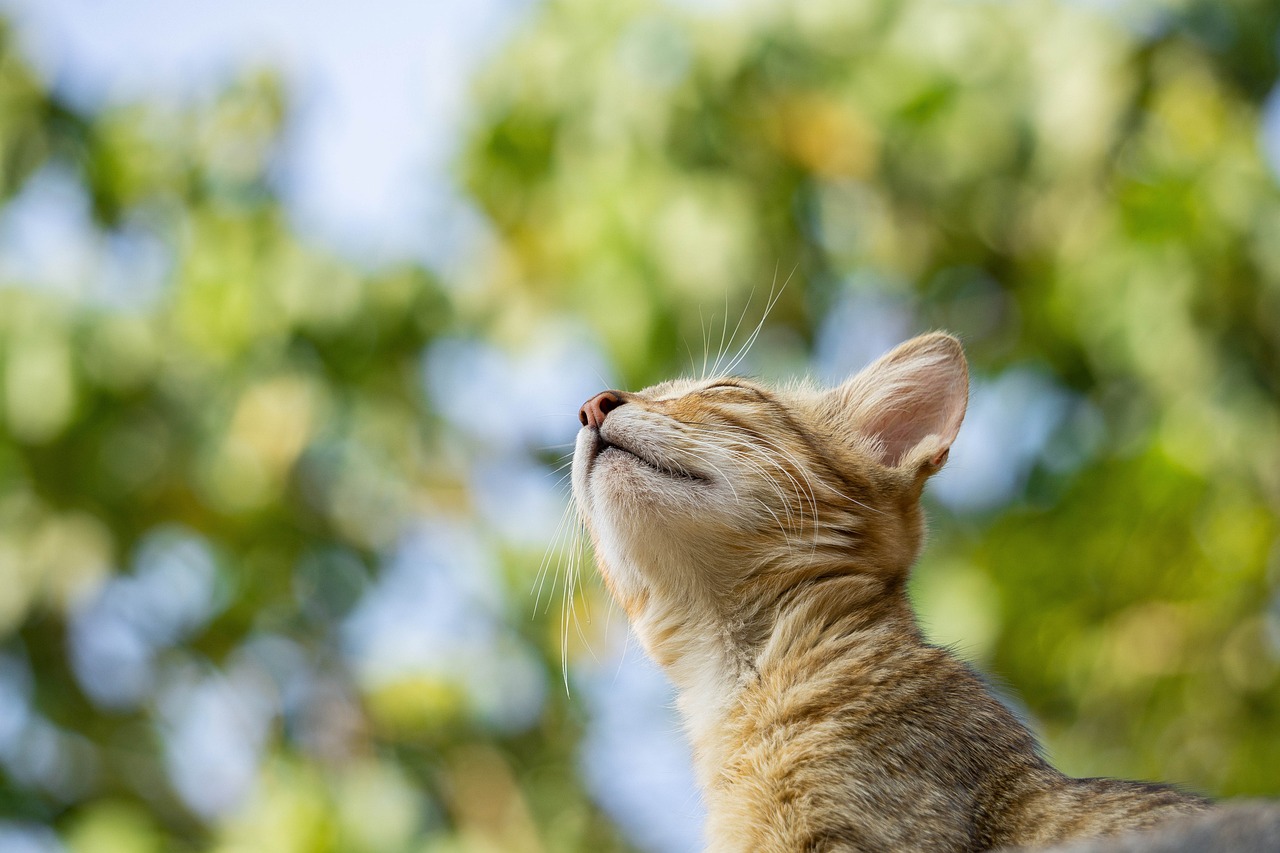
Creating a Positive Environment
Creating a positive environment for grooming is essential to ensure that your pet feels safe and comfortable. Just like humans, pets can sense the atmosphere around them, and a calm setting can make all the difference. Imagine walking into a room filled with soothing music and soft lighting; it immediately puts you at ease. The same principle applies to your furry friend! To start, ensure that the grooming area is free from distractions and loud noises. This could mean turning off the television or moving to a quieter part of the house. The goal is to create a space that feels like a sanctuary for your pet, where they can relax and enjoy the grooming process.
Another important aspect is to ensure that the grooming tools are organized and easily accessible. Nothing disrupts a peaceful environment like rummaging through drawers looking for a brush! Consider using a grooming cart or a designated shelf to keep everything neat. When your pet sees you calmly reaching for the tools, they’ll feel more secure knowing that you are prepared and in control.
Moreover, consider the temperature of the grooming area. Pets can be sensitive to heat and cold, so ensure the space is comfortable. If it's too hot, your pet may become irritable, and if it's too cold, they may feel anxious. A comfortable environment sets the stage for a more enjoyable grooming experience.
Finally, don't underestimate the power of positive reinforcement. Incorporating treats and praise into the grooming routine can create strong positive associations. For instance, after a successful grooming session, reward your pet with their favorite treat or a fun playtime session. This not only helps them associate grooming with something pleasant but also strengthens your bond. Think of it as a little celebration after a job well done!
In summary, by creating a nurturing and positive environment, you can significantly reduce your pet's anxiety about grooming. Remember, a little preparation goes a long way in making the grooming experience enjoyable for both you and your pet. As you embark on this grooming journey, keep these elements in mind to foster a sense of trust and comfort.
- How can I tell if my pet is stressed during grooming? Look for signs like panting, whining, or trying to escape. If you notice these behaviors, take a break and give your pet some space.
- What should I do if my pet doesn't like being groomed? Start slowly and use desensitization techniques. Introduce grooming tools gradually and reward them for calm behavior.
- How often should I groom my pet? This varies by breed and coat type. Generally, long-haired breeds require more frequent grooming than short-haired ones.
- Can I use human shampoo on my pet? No, human shampoos can disrupt the pH balance of your pet's skin. Always use products specifically designed for pets.
Using Treats and Rewards
When it comes to grooming your pet, one of the most effective ways to create a positive experience is by incorporating treats and rewards into the process. Just like humans, pets thrive on positive reinforcement. Think of it as a little incentive to make them feel good about what can sometimes be a stressful situation. By rewarding your furry friend, you can help them associate grooming with pleasure rather than anxiety.
Start by choosing some of your pet's favorite treats. You know your pet best, so whether it's crunchy biscuits, soft chews, or even a bit of cooked chicken, having something they love on hand can work wonders. The key is to use these treats strategically. For instance, you can offer a treat right after brushing a particular area or once they’ve successfully endured a bath. This not only encourages them to behave well but also builds a strong bond between you and your pet.
Another effective method is to use praise alongside treats. A simple “Good boy!” or “You’re such a good girl!” can go a long way. Your voice can be a powerful tool in making your pet feel safe and loved. It’s essential to maintain a calm and cheerful tone, as pets are quite sensitive to our emotions. By combining verbal praise with tasty treats, you create a multi-sensory reward system that reinforces positive behavior.
Here’s a quick guide on how to effectively use treats and rewards during grooming:
| Step | Action | Expected Outcome |
|---|---|---|
| 1 | Introduce the grooming tool slowly. | Your pet remains calm and curious. |
| 2 | Give a treat when your pet shows calm behavior. | Positive association with the grooming tool. |
| 3 | Start grooming for a short time. | Your pet tolerates the grooming session. |
| 4 | Provide a treat after the session. | Your pet looks forward to the next grooming session. |
Consistency is crucial. If you only reward your pet occasionally, they might not fully grasp the connection between good behavior during grooming and receiving treats. Make it a habit to reward them every time they handle grooming well. Over time, you’ll notice that your pet becomes more relaxed and even starts to enjoy the grooming routine.
Lastly, remember that patience is key. Some pets may take longer to adjust than others. If your furry friend shows signs of anxiety, don’t push them too hard. Instead, take a step back, give them some time, and try again later. The goal is to create a positive grooming experience that both you and your pet can look forward to!
- How often should I groom my pet? The frequency depends on your pet's breed and coat type. Long-haired breeds may need grooming several times a week, while short-haired pets might only need it once a month.
- What if my pet doesn't like being groomed? Start slowly and use treats to create positive associations. Gradually increase the duration of grooming sessions as your pet becomes more comfortable.
- Can I use human shampoo on my pet? No, human shampoos can irritate your pet's skin. Always use pet-specific shampoos that cater to their skin and coat type.
- What if my pet shows signs of aggression during grooming? If your pet becomes aggressive, it’s crucial to stop immediately. Consult a professional groomer or a veterinarian for advice on how to handle the situation.
Desensitization Techniques
Desensitization techniques are essential for easing your pet into grooming routines, especially if they show signs of anxiety or discomfort. The goal here is to gradually introduce your furry friend to grooming tools and processes without overwhelming them. Think of it like teaching a child to ride a bike; you wouldn’t just throw them on without any preparation, right? Instead, you’d start with training wheels and take it slow. Similarly, you can break down the grooming process into manageable steps for your pet.
Start by allowing your pet to become familiar with the grooming tools without any actual grooming taking place. For instance, let them sniff the brush or comb while you’re sitting with them in a relaxed environment. You can even place the tools near their favorite resting spot, allowing them to associate these items with comfort and safety. This initial exposure is crucial as it sets the stage for positive associations.
Once your pet seems comfortable with the tools, you can begin to introduce short sessions of grooming. Start with just a few strokes with the brush or comb, and then immediately reward them with a treat or praise. This creates a positive feedback loop, reinforcing the idea that grooming equals good things. Keep these sessions brief at first—just a minute or two—and gradually increase the duration as your pet becomes more comfortable.
Another effective technique is to incorporate grooming into playtime. For example, you can use a brush as a toy at first, allowing your pet to play with it before transitioning into actual grooming. This playful approach can help reduce anxiety and make your pet more receptive to the grooming process. Additionally, try to maintain a calm and soothing voice throughout the grooming sessions, as your tone can significantly influence your pet's comfort level.
Here’s a simple table to summarize the key steps in desensitization:
| Step | Description |
|---|---|
| Familiarization | Let your pet sniff and explore grooming tools without any grooming. |
| Short Sessions | Begin with brief grooming sessions, rewarding with treats afterward. |
| Playful Approach | Incorporate grooming tools into playtime to create positive associations. |
| Calm Environment | Use a soothing voice and maintain a relaxed atmosphere during grooming. |
Lastly, patience is key. Just like humans, pets have their own unique pace of learning. If your pet shows signs of stress, take a step back and slow down the process. It’s essential to listen to their body language and adjust your approach accordingly. Over time, with consistent and gentle desensitization techniques, your pet will become more comfortable with grooming, transforming it from a dreaded chore into a bonding experience.
- How long does it take for a pet to get used to grooming? It varies by pet, but with consistent practice, most pets can adjust within a few weeks.
- What if my pet still shows signs of anxiety after desensitization? Consider consulting a veterinarian or a professional groomer for additional strategies.
- Are there specific tools to help with desensitization? Yes, tools like soft brushes and gentle clippers can make the process easier.
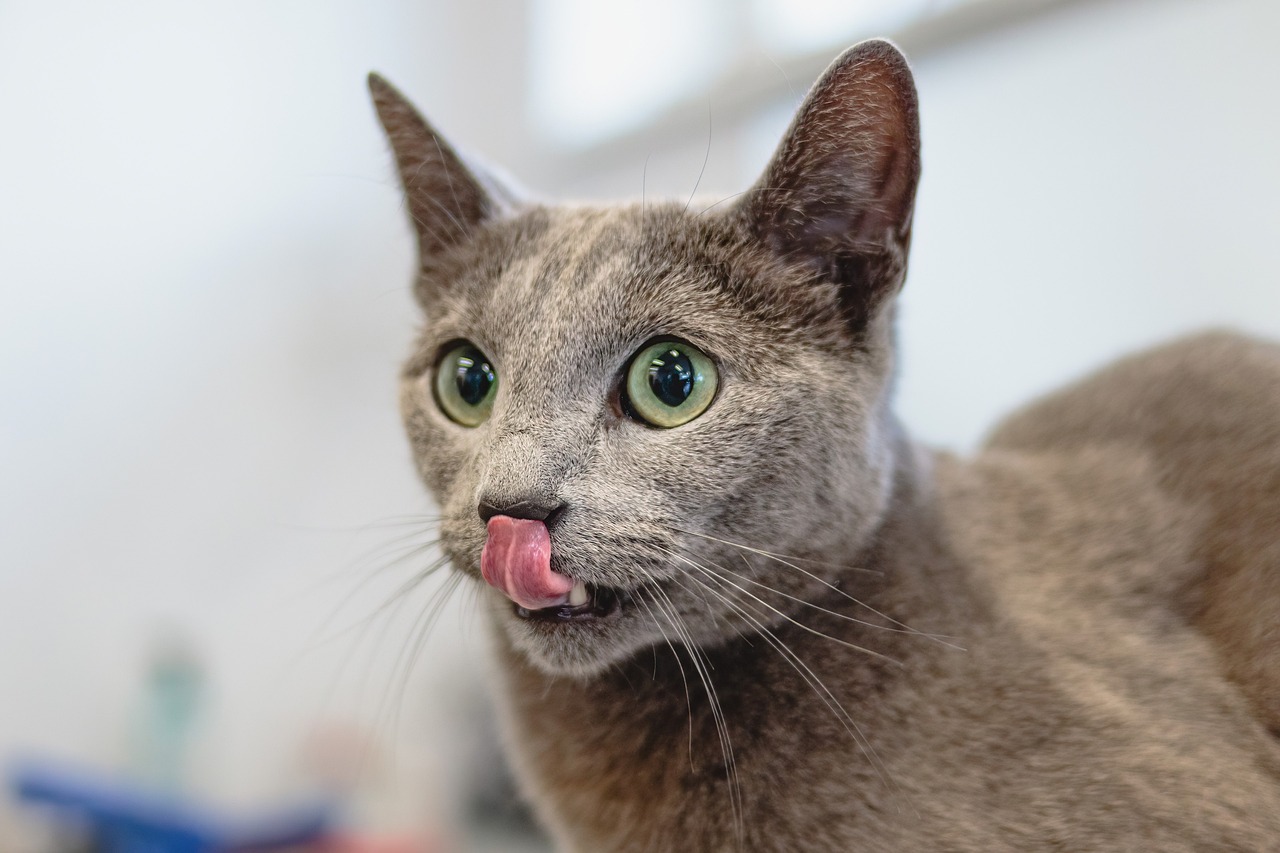
Establishing a Routine
When it comes to grooming your beloved pet, establishing a routine is not just a good idea—it's essential! Think of it as your pet's version of a spa day, where they can feel pampered and loved while also maintaining their hygiene. A consistent grooming schedule not only helps keep your furry friend looking fabulous but also allows them to become accustomed to the process, reducing anxiety and stress over time.
So, how do you go about creating a routine that works for both you and your pet? Start by choosing a specific day and time each week dedicated to grooming. This could be every Saturday morning or every Wednesday afternoon—whatever fits your lifestyle best. The key is to stick to it! Just like we thrive on routine, pets find comfort in predictability. They’ll soon learn that grooming is a regular part of their week, which can make the entire experience more enjoyable.
Next, consider the frequency of grooming. Different breeds and coat types require varying levels of attention. For example, long-haired breeds may need grooming several times a week to prevent mats and tangles, while short-haired breeds might only need a quick brush once a week. Here’s a quick breakdown:
| Breed Type | Recommended Grooming Frequency |
|---|---|
| Long-haired breeds (e.g., Shih Tzu, Persian) | 2-3 times a week |
| Medium-haired breeds (e.g., Cocker Spaniel, Beagle) | Once a week |
| Short-haired breeds (e.g., Boxer, Beagle) | Every 1-2 weeks |
| Hairless breeds (e.g., Sphynx) | Weekly for skin care |
Now, while establishing this routine, it’s crucial to monitor your pet’s comfort levels during each grooming session. Pay attention to their body language—are they relaxed or tense? Signs of discomfort may include whining, trying to escape, or excessive panting. If you notice any of these behaviors, it might be time to take a step back and reassess your approach. Perhaps you need to take it slower or offer more breaks during grooming. Remember, the goal is to create a positive experience for your pet!
Incorporating short grooming sessions into your routine can also be beneficial. If your pet is particularly anxious, start with just a few minutes of brushing or combing, gradually increasing the time as they become more comfortable. This way, you can build up their tolerance without overwhelming them. Think of it like training for a marathon; you wouldn’t run 26 miles on your first day, right?
Lastly, don’t forget to celebrate the little victories! After each grooming session, reward your pet with a treat or some extra playtime. This positive reinforcement will help them associate grooming with good things, making them more likely to look forward to it in the future. In essence, establishing a grooming routine is about creating a positive, stress-free environment that both you and your pet can enjoy together.
- How often should I groom my pet? The frequency depends on your pet's breed and coat type. Long-haired breeds may need grooming 2-3 times a week, while short-haired breeds might only need it every 1-2 weeks.
- What should I do if my pet is anxious during grooming? Start with short sessions and gradually increase the time. Pay attention to their comfort levels and use treats to reinforce positive behavior.
- Can I groom my pet at home, or should I take them to a professional? Many pets can be groomed at home, but if you're unsure or if your pet has special grooming needs, consider consulting a professional groomer.
Frequency of Grooming
When it comes to grooming your furry friend, one of the most common questions pet owners ask is, "How often should I groom my pet?" The answer isn't one-size-fits-all; it greatly depends on various factors including your pet's breed, coat type, and even their lifestyle. For instance, long-haired breeds like the Yorkshire Terrier or Persian Cat require more frequent grooming—typically every 4 to 6 weeks—to prevent mats and tangles. On the other hand, short-haired breeds like the Beagle or Boxer may only need grooming every 6 to 8 weeks.
To make things clearer, let’s break it down by pet type and coat characteristics. Here’s a quick reference table for your convenience:
| Pet Type | Coat Type | Recommended Grooming Frequency |
|---|---|---|
| Dog | Long-haired | Every 4-6 weeks |
| Dog | Short-haired | Every 6-8 weeks |
| Cat | Long-haired | Every 4-6 weeks |
| Cat | Short-haired | Every 8-12 weeks |
But it's not just about the type of coat; the lifestyle of your pet plays a significant role too. If your dog loves to roll around in the mud or your cat enjoys outdoor adventures, you might find yourself needing to groom them more frequently. Regular grooming not only keeps your pet looking sharp but also helps you spot any skin issues or parasites early on. Think of it as a bonding experience; you’re not just maintaining their appearance but also checking in on their health.
Another key aspect to consider is your pet's comfort. If your pet seems anxious or uncomfortable during grooming sessions, it might be a sign that you're grooming too frequently or not frequently enough. Paying attention to your pet's body language can provide valuable insights. For example, if they’re squirming or trying to escape, it might be time to reassess your grooming routine. Remember, the goal is to create a positive experience that both you and your pet can enjoy.
In summary, establishing a grooming frequency that suits your pet's needs is crucial. Whether your furry companion is a fluffy Golden Retriever or a sleek Siamese, understanding their unique grooming requirements will help you maintain their health and happiness. So, keep an eye on that coat and adjust your grooming schedule as needed—your pet will thank you for it!
- How often should I groom my dog? - This depends on the breed and coat type. Long-haired dogs generally need grooming every 4-6 weeks, while short-haired dogs can go 6-8 weeks.
- Can I groom my pet at home? - Absolutely! With the right tools and techniques, many pet owners successfully groom their pets at home.
- What tools do I need for grooming? - Basic tools include brushes, combs, and clippers. The specific tools will depend on your pet's coat type.
- What if my pet hates grooming? - Gradually introduce grooming tools and use treats to create positive associations. Patience is key!
Monitoring Your Pet's Comfort
When it comes to grooming your furry friend, monitoring their comfort is crucial to ensure a positive experience. Just like us, pets can experience discomfort, stress, and anxiety during grooming sessions. By being attentive to their behavior and body language, you can make necessary adjustments to keep them calm and happy. So, what should you be looking for? Let's dive into some key signs of discomfort and how to address them.
First and foremost, observe your pet's body language. Are they tensing up or trying to escape? These are clear indicators that your pet is feeling uneasy. Other signs include excessive panting, whining, or even growling. Each of these behaviors can signal that your pet needs a break or a change in approach. For example, if your dog is shifting away from the grooming tool, it might be time to pause and offer some reassurance.
Another important aspect of monitoring your pet's comfort is to pay attention to their vocalizations. Some pets may express their discomfort through sounds. If your pet is whining or barking excessively, it could be a sign that they are feeling overwhelmed. In such cases, consider taking a step back and allowing your pet to relax. You might even want to incorporate short breaks into your grooming routine to help them decompress.
Additionally, it's essential to observe how your pet reacts to different grooming tools. For instance, some pets may be sensitive to the sound of clippers or the sensation of a brush. If you notice your pet flinching or becoming restless when you use a specific tool, consider switching to a different one that they may find more comfortable. This is where trial and error can come into play, as finding the right tools can make a world of difference.
To help you better understand your pet's comfort levels, here’s a quick reference table to guide you:
| Behavior | Possible Interpretation | Recommended Action |
|---|---|---|
| Tensing up | Feeling anxious or uncomfortable | Pause grooming and offer reassurance |
| Excessive panting | Overheating or stress | Take a break and provide water |
| Whining or growling | Feeling threatened or frightened | Stop grooming and check for pain or discomfort |
| Trying to escape | Overwhelmed or scared | Reassess the grooming environment and tools |
Lastly, don't forget to communicate with your pet throughout the grooming process. Use a calm and soothing voice to reassure them, and don’t hesitate to reward them with treats for good behavior. This not only helps in building a positive association with grooming but also makes the experience more enjoyable for both of you.
By keeping an eye on your pet's comfort and making adjustments as needed, you’ll turn grooming from a dreaded chore into a bonding experience. Remember, the goal is to create a safe and enjoyable environment where your pet feels loved and cared for.
- How often should I groom my pet? The frequency depends on your pet's breed and coat type. Long-haired breeds may need grooming several times a week, while short-haired breeds might only require it monthly.
- What if my pet hates grooming? Start slowly and use positive reinforcement techniques. Gradually introduce them to grooming tools and give them treats to create a positive association.
- Can I groom my pet at home? Absolutely! With the right tools and techniques, you can groom your pet at home. Just make sure to educate yourself on the best practices for your pet's specific needs.
Frequently Asked Questions
- How can I tell if my pet is stressed during grooming?
Pets often show stress through body language. Look for signs like panting, whining, or trying to escape. If your pet's ears are back or their tail is tucked, they might be feeling anxious. It’s essential to pay attention to these signals to create a more comfortable grooming experience.
- What grooming tools do I need for my specific pet type?
The right grooming tools depend on your pet's coat type. For example, long-haired breeds often need slicker brushes, while short-haired pets might do well with bristle brushes. Always choose tools that suit your pet's fur to make grooming easier and more enjoyable for both of you.
- How often should I groom my pet?
Grooming frequency varies by breed and coat type. Generally, long-haired pets need grooming every few days, while short-haired ones can be groomed weekly. Establishing a routine helps your pet get used to the process, making it smoother over time.
- Can I use human shampoo on my pet?
No, human shampoos can irritate your pet’s skin because they have different pH levels. Always use shampoos specifically formulated for pets to ensure their skin and coat remain healthy and comfortable.
- What should I do if my pet resists grooming?
If your pet resists grooming, try introducing the tools gradually. Use treats and praise to create positive associations. If they still seem uncomfortable, take breaks and gradually increase the grooming time as they become more accustomed to the process.
- How can I make grooming a positive experience for my pet?
Incorporate treats and rewards during grooming sessions. Use a calm voice and gentle touches to reassure your pet. Creating a relaxing environment can also help them feel more at ease, making the grooming process enjoyable.
- What are desensitization techniques in grooming?
Desensitization involves slowly introducing your pet to grooming tools without performing the full grooming session. Start by letting them sniff the tools, then gradually introduce short grooming sessions. Over time, this can help reduce their anxiety about the process.
- How do I know if my pet is comfortable during grooming?
Monitor your pet’s body language closely. Signs of comfort include relaxed body posture, wagging tails, or leaning into the grooming process. If they seem tense or try to escape, it may be time to reassess your approach and give them a break.

